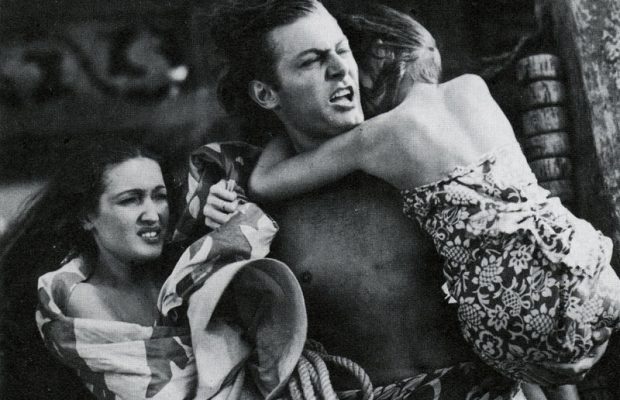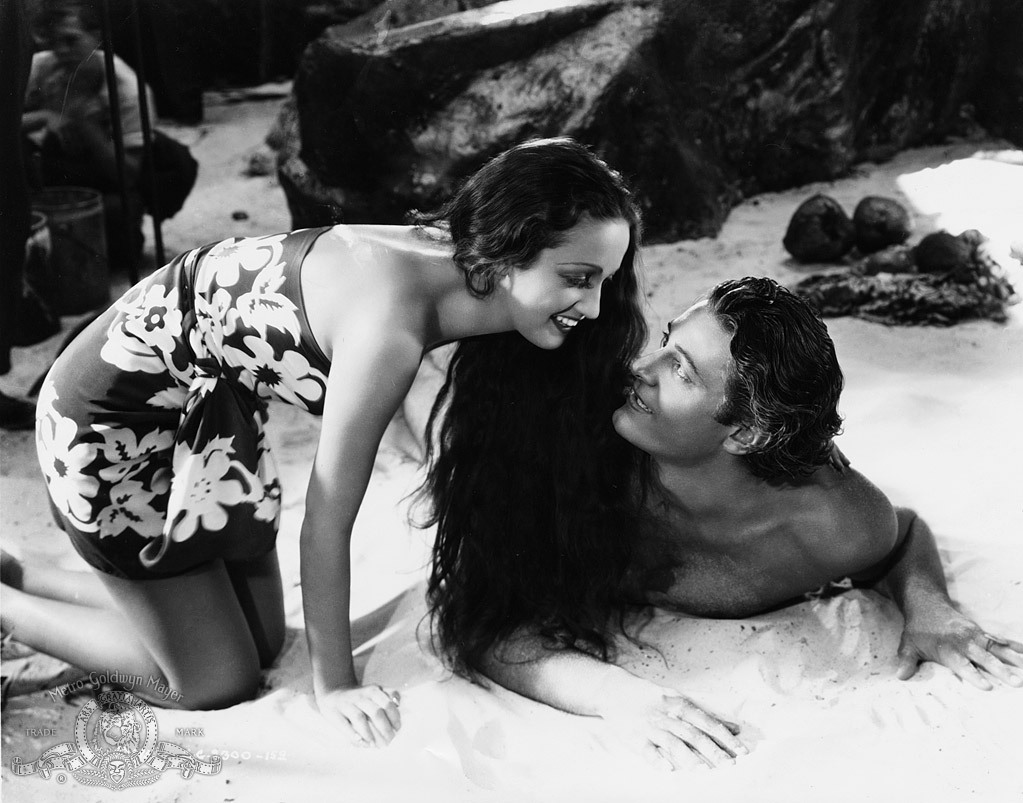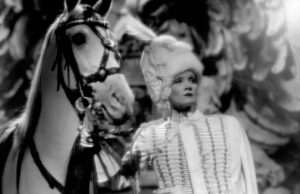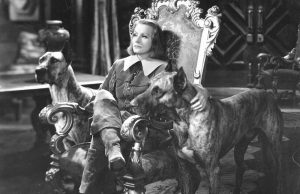The Hurricane (1937)

Toronto Film Society presented The Hurricane (1937) on Monday, April 17, 2023 as part of the Season 75 Monday Evening Film Buffs Series, Programme 7.
Producer: United Artists. Producer: Lewis Milestone. Director: John Ford. Screenplay: Dudley Nichols and Oliver H.P. Garrett, based on The Hurricane (novel) by James Norman Hall and Charles Nordhoff. Cinematography: Bert Glennon. Music: Alfred Newman. Film Editor: Lloyd Nosier. Release date: November 9, 1937.
Cast: Dorothy Lamour (Marama), Jon Hall (Terangi), Mary Astor, (Mme. DeLaage), C. Aubrey Smith (Father Paul), Thomas Mitchell (Dr. Kersaint), Raymond Massey (DeLaage), John Carradine (Warden).
At first glance, John Ford’s 1937 film The Hurricane may seem a most atypical entry in the legendary filmmaker’s long and storied career. Known largely for westerns (particularly his association with John Wayne) and classic literary adaptations, The Hurricane is a relatively early effort from Ford that actually contains several important thematic elements that would go on to define his later body of work.
The novel by Charles Nordhoff and James Norman Hall on which the film was based, was serialized in The Saturday Evening Post. Producer Samuel Goldwyn purchased the film rights, and he originally intended to produce the film in Technicolor, but the cost became too prohibitive. Goldwyn had hoped to shoot the entire picture on location in the South Seas, but the expense and difficulty of transporting the equipment, combined with the possible adverse weather conditions, necessitated that the picture be shot in Hollywood.
The Hurricane can be described as an exciting romantic drama set in the South Pacific that concludes as a disaster film, a setting and genre for which Ford could hardly have been accused of being associated with. The story is set on a small, idyllic island whose peaceful existence is disrupted by the arrival of a new governor, played by Raymond Massey. The governor is accompanied by his wife, played by Mary Astor, and his second-in-command, played by C. Aubrey Smith. The main story is of a Polynesian sailor named Terangi (played by Jon Hall) who, after being wed to his bride Marama (Dorothy Lamour), becomes unjustly imprisoned for assaulting a white man.
Over the course of the story, Terangi continually tries to escape from prison but is caught and given increasingly harsh sentences. As a devastating hurricane approaches his native island, Terangi must rescue his wife and child before disaster strikes.
The theme of man versus nature in his natural surroundings is a powerful and enduring element in Ford’s films, and The Hurricane is no exception. His careful framing of Hall and Lamour’s characters against the background of tropical vistas first shows the beauty of their surroundings, but as the hurricane approaches, the same natural beauty becomes a source of danger and destruction. This same aesthetic can be seen in many of Ford’s westerns, with the characters framed against carefully composed vistas to show the threatening beauty of their surroundings.
Ford’s films also focus on the importance of family and community and the way that individuals come together to support and protect each other. This is prevalent throughout The Hurricane, with Terangi risking life and limb to be with his family, and the islanders banding together to protect him and those he loves.
Terangi’s character and actions throughout the film are reflective of Ford’s penchant for strong male protagonists whose characters reflect masculinity, courage, stoicism, and physical strength in the face of adversity. However, he also portrays the vulnerabilities and weaknesses of these characters and explores the ways in which their masculinity is tested and challenged. In this case, Terangi is pushed to the limit, first by his harsh French captors, then by the very power of nature itself.
The Hurricane showcases Ford’s skill in directing action sequences. The film’s climactic storm sequence is a tour de force of filmmaking that was praised for its sense of realism that was rare for films of the time, featuring impressive special effects that still dazzle today. The sequence is thrilling and intense, and it showcases Ford at the top of his game.
According to Life Magazine, special effects wizard James Basevi was given a budget of $400,000 to achieve his effects. He spent $150,000 to build a 2 ½ acre native village with a lagoon on the United Artists studio backlot, then spent $250,000 destroying it.
The film’s special effects were so praised by the public and critics alike that that they petitioned to the Academy of Motion Picture Arts and Sciences for the film to receive a special Oscar. A New York Times film critic said of the climactic scene: “It is a hurricane to blast you from the orchestra pit to the first mezzanine. It is a hurricane to film your eyes with spin-drift, to beat at your ears with its thunder, to clutch at your heart and send your diaphragm vaulting over your floating rib into the region just south of your tonsils.”
This and other recent films with highly praised effects, including San Francisco (1936) and In Old Chicago (1938) laid the groundwork for the Academy to create an awards category for special effects, which were first awarded in 1939.
Although perhaps not considered among Ford’s most recognized films, The Hurricane remains a classic whose achievements continue to impress viewers almost 90 years after its release.
Notes by Michael Powell

SPOT THE CANADIAN by Leslie Smith
James Basevi, who designed the spectacular special effects for 1937’s The Hurricane, can be deemed a semi-Canadian. Born in Plymouth, England on September 21st, 1890, Basevi emigrated to Calgary in 1911, working there as a draughtsman for the architecture firm of Holman & Gotch. When WWI broke out, he joined the 2nd Canadian Division as a machine gunner, earning special mentions and decorations, plus the rank of major. Demobbed, Basevi returned to Calgary, where he teamed up with J.E. Burrell in an architectural partnership.
In 1922, seeking greater fields of endeavour, the British-Canadian moved to Hollywood. Here, he quickly became a sought-after art director and special effects maven. From 1925—29 and again from 1936—1940, he was head of MGM’s special effects department, and worked as well for United Artists. Basevi shifted to 20th Century Fox in 1941, first as supervising art director and then, in 1945, as head of the art department. Leaving Fox in 1947, he briefly joined RKO (1948–50) and then Warner Brothers (1953—54), thereafter going freelance. He died in Bellflower, California in 1962, survived by his long-time wife.
He was also survived by an amazing list of first-rate movies and memorable effects. In addition to The Hurricane’s storm sequences, Basevi created the earthquake scenes in San Francisco (1936) and the plague of locusts in The Good Earth (1937). Other credits include Raffles (1939) and a pair of John Ford classics: My Darling Clementine (1946) and She Wore a Yellow Ribbon (1949). In 1945, he was loaned out to David O. Selznick to recreate the Salvador Dalí paintings used in the haunting dream sequence for Hitchcock’s Spellbound (1945).
Basevi was nominated four times for an Academy Award in art direction – for Wuthering Heights (1939), The Westerner (1940), The Gang’s All Here (1943) and The Keys of the Kingdom (1944). In 1943, he shared an Oscar win in art direction with William S. Darling for The Song of Bernadette (1943).
Op Cit
Toronto-born Raymond Massey plays DeLaage.
Art direction by Victoria’s Richard Day.










Leave a Reply